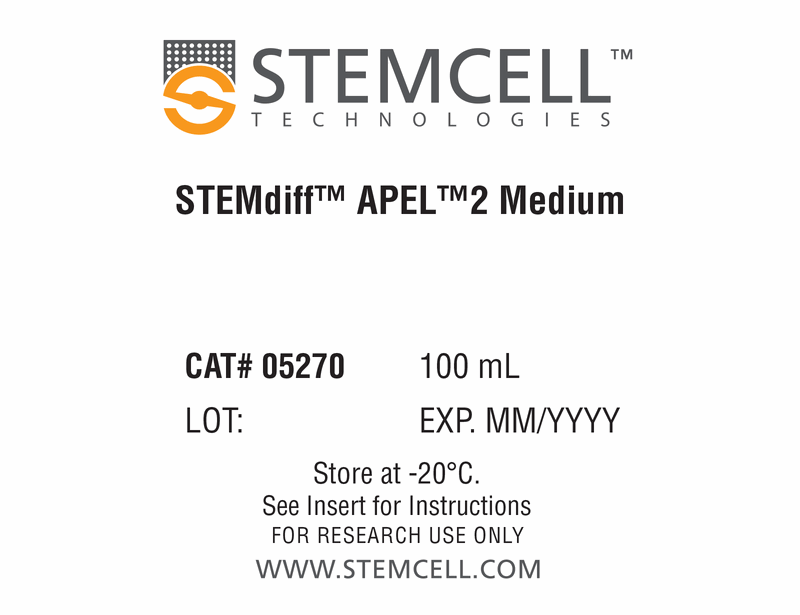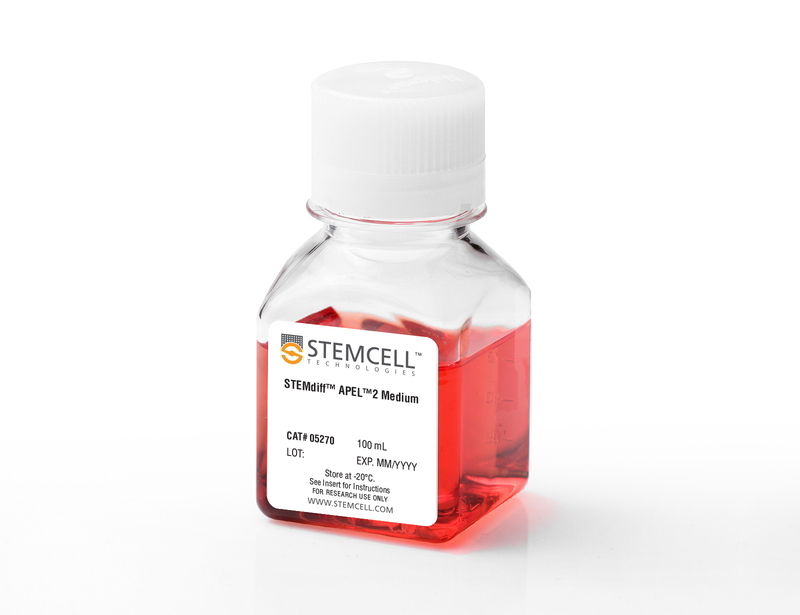STEMdiff™ APEL™2 Medium
Defined, animal component-free medium for differentiation of human ES and iPS cells to multiple lineages
概要
STEMdiff™ APEL™ 2 Medium is a fully defined, serum-free and animal component-free medium for the differentiation of human embryonic stem (ES) cells and induced pluripotent stem (iPS) cells. It is based on the APEL formulation published by Dr. Andrew Elefanty and lacks undefined components such as protein-free hybridoma medium.
STEMdiff™ APEL™ 2 can be used in adherent or embryoid body (EB)-based protocols, such as with AggreWell™. It can be used with a variety of different induction factors or cytokines to support differentiation along ectoderm, mesoderm and endoderm lineages.
STEMdiff™ APEL™ 2 can be used in adherent or embryoid body (EB)-based protocols, such as with AggreWell™. It can be used with a variety of different induction factors or cytokines to support differentiation along ectoderm, mesoderm and endoderm lineages.
Advantages
• Compatible with TeSR™-cultured human ES and iPS cells
• Compatible with adherent or EB culture differentiation protocols
• Capable of supporting endoderm, mesoderm and ectoderm differentiation, when specific cytokines or induction factors are added
• Compatible with adherent or EB culture differentiation protocols
• Capable of supporting endoderm, mesoderm and ectoderm differentiation, when specific cytokines or induction factors are added
Subtype
Specialized Media
Cell Type
Pluripotent Stem Cells
Species
Human
Application
Cell Culture, Differentiation
Brand
STEMdiff
Area of Interest
Drug Discovery and Toxicity Testing, Stem Cell Biology
Formulation
Animal Component-Free, Serum-Free
技术资料
| Document Type | 产品名称 | Catalog # | Lot # | 语言 |
|---|---|---|---|---|
| Product Information Sheet | STEMdiff™ APEL™2 Medium | 05270, 05275 | All | English |
| Safety Data Sheet | STEMdiff™ APEL™2 Medium | 05270, 05275 | All | English |
数据及文献
Publications (16)
Cell stem cell 2020 jun
Metabolic Reprograming via Deletion of CISH in Human iPSC-Derived NK Cells Promotes In Vivo Persistence and Enhances Anti-tumor Activity.
Abstract
Abstract
Cytokine-inducible SH2-containing protein (CIS; encoded by the gene CISH) is a key negative regulator of interleukin-15 (IL-15) signaling in natural killer (NK) cells. Here, we develop human CISH-knockout (CISH-/-) NK cells using an induced pluripotent stem cell-derived NK cell (iPSC-NK cell) platform. CISH-/- iPSC-NK cells demonstrate increased IL-15-mediated JAK-STAT signaling activity. Consequently, CISH-/- iPSC-NK cells exhibit improved expansion and increased cytotoxic activity against multiple tumor cell lines when maintained at low cytokine concentrations. CISH-/- iPSC-NK cells display significantly increased in vivo persistence and inhibition of tumor progression in a leukemia xenograft model. Mechanistically, CISH-/- iPSC-NK cells display improved metabolic fitness characterized by increased basal glycolysis, glycolytic capacity, maximal mitochondrial respiration, ATP-linked respiration, and spare respiration capacity mediated by mammalian target of rapamycin (mTOR) signaling that directly contributes to enhanced NK cell function. Together, these studies demonstrate that CIS plays a key role to regulate human NK cell metabolic activity and thereby modulate anti-tumor activity.
NeuroReport 2018
Generation of human vascularized brain organoids
Abstract
Abstract
The aim of this study was to vascularize brain organoids with a patient's own endothelial cells (ECs). Induced pluripotent stem cells (iPSCs) of one UC Davis patient were grown into whole-brain organoids. Simultaneously, iPSCs from the same patient were differentiated into ECs. On day 34, the organoid was re-embedded in Matrigel with 250 000 ECs. Vascularized organoids were grown in vitro for 3-5 weeks or transplanted into immunodeficient mice on day 54, and animals were perfused on day 68. Coating of brain organoids on day 34 with ECs led to robust vascularization of the organoid after 3-5 weeks in vitro and 2 weeks in vivo. Human CD31-positive blood vessels were found inside and in-between rosettes within the center of the organoid after transplantation. Vascularization of brain organoids with a patient's own iPSC-derived ECs is technically feasible.
Stem cell research 2017 APR
Rapid establishment of the European Bank for induced Pluripotent Stem Cells (EBiSC) - the Hot Start experience.
Abstract
Abstract
A fast track Hot Start" process was implemented to launch the European Bank for Induced Pluripotent Stem Cells (EBiSC) to provide early release of a range of established control and disease linked human induced pluripotent stem cell (hiPSC) lines. Established practice amongst consortium members was surveyed to arrive at harmonised and publically accessible Standard Operations Procedures (SOPs) for tissue procurement
Stem Cell Research 2016 JUN
Generation of functional podocytes from human induced pluripotent stem cells
Abstract
Abstract
Generating human podocytes in vitro could offer a unique opportunity to study human diseases. Here, we describe a simple and efficient protocol for obtaining functional podocytes in vitro from human induced pluripotent stem cells. Cells were exposed to a three-step protocol, which induced their differentiation into intermediate mesoderm, then into nephron progenitors and, finally, into mature podocytes. After differentiation, cells expressed the main podocyte markers, such as synaptopodin, WT1, α-Actinin-4, P-cadherin and nephrin at the protein and mRNA level, and showed the low proliferation rate typical of mature podocytes. Exposure to Angiotensin II significantly decreased the expression of podocyte genes and cells underwent cytoskeleton rearrangement. Cells were able to internalize albumin and self-assembled into chimeric 3D structures in combination with dissociated embryonic mouse kidney cells. Overall, these findings demonstrate the establishment of a robust protocol that, mimicking developmental stages, makes it possible to derive functional podocytes in vitro.
Experimental hematology 2016 JAN
GSK3$\$ activates the CDX/HOX pathway and promotes hemogenic endothelial progenitor differentiation from human pluripotent stem cells.
Abstract
Abstract
WNT/$\$-CATENIN signaling promotes the hematopoietic/endothelial differentiation of human embryonic stem cells and human induced pluripotent stem cells (hiPSCs). The transient addition of a GSK3$\$ (GSKi) has been found to facilitate in vitro endothelial cell differentiation from hESCs/hiPSCs. Because hematopoietic and endothelial cells are derived from common progenitors (hemogenic endothelial progenitors [HEPs]), we examined the effect of transient GSKi treatment on hematopoietic cell differentiation from hiPSCs. We found that transient GSKi treatment at the start of hiPSC differentiation induction altered the gene expression profile of the cells. Multiple CDX/HOX genes, which are expressed in the posterior mesoderm of developing embryos, were significantly upregulated by GSKi treatment. Further, inclusion of the GSKi in a serum- and stroma-free culture with chemically defined medium efficiently induced HEPs, and the HEPs gave rise to various lineages of hematopoietic and endothelial cells. Therefore, transient WNT/$\$-CATENIN signaling triggers activation of the CDX/HOX pathway, which in turn confers hemogenic posterior mesoderm identity to differentiating hiPSCs. These data enhance our understanding of human embryonic hematopoietic/endothelial cell development and provide a novel in vitro system for inducing the differentiation of hematopoietic cells from hiPSCs.
Stem cells and development 2015 MAY
Improved hematopoietic differentiation efficiency of gene-corrected beta-thalassemia induced pluripotent stem cells by CRISPR/Cas9 system.
Abstract
Abstract
The generation of beta-thalassemia ($\$-Thal) patient-specific induced pluripotent stem cells (iPSCs), subsequent homologous recombination-based gene correction of disease-causing mutations/deletions in the $\$-globin gene (HBB), and their derived hematopoietic stem cell (HSC) transplantation offers an ideal therapeutic solution for treating this disease. However, the hematopoietic differentiation efficiency of gene-corrected $\$-Thal iPSCs has not been well evaluated in the previous studies. In this study, we used the latest gene-editing tool, clustered regularly interspaced short palindromic repeats (CRISPR)/CRISPR-associated 9 (Cas9), to correct $\$-Thal iPSCs; gene-corrected cells exhibit normal karyotypes and full pluripotency as human embryonic stem cells (hESCs) showed no off-targeting effects. Then, we evaluated the differentiation efficiency of the gene-corrected $\$-Thal iPSCs. We found that during hematopoietic differentiation, gene-corrected $\$-Thal iPSCs showed an increased embryoid body ratio and various hematopoietic progenitor cell percentages. More importantly, the gene-corrected $\$-Thal iPSC lines restored HBB expression and reduced reactive oxygen species production compared with the uncorrected group. Our study suggested that hematopoietic differentiation efficiency of $\$-Thal iPSCs was greatly improved once corrected by the CRISPR/Cas9 system, and the information gained from our study would greatly promote the clinical application of $\$-Thal iPSC-derived HSCs in transplantation.


